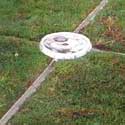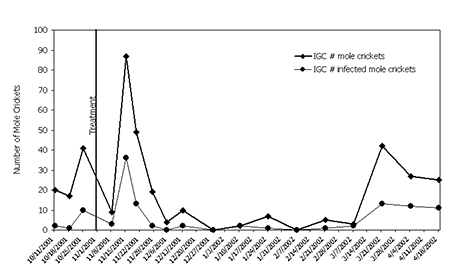Beneficial Nematodes in Turf: Good for How Many Years Against Pest Mole Crickets?
By: Howard Frank, Eileen Buss, and Kathryn Barbara, University of Florida, IFAS
The July/August 1999 issue of Florida Turf Digest on pages 32 and 34-35 carried an article about the beneficial nematode Steinernema scapterisci, which attacks and kills the large nymphs and adults of pest mole crickets. The article described how the UF/IFAS Mole Cricket Research Program in August-October 1989 applied these nematodes on 2.5-acre plots in pastures in six Florida counties. Under high natural soil moisture conditions each of the plots received 2 billion nematodes. Thirteen pitfall traps were operated in each of the fields for two years (Fig. 1). Mole crickets trapped in the pitfalls week after week were shipped to Gainesville and held in the laboratory until they died. Nematodes that emerged from the dead mole crickets were identified and recorded. This research showed that the progeny of the nematodes survived for two years and slowly spread outward from the plots through the rest of each field.
 Fig.1.
Linear pitfall trap used to collect insects that walk on the ground.
Fig.1.
Linear pitfall trap used to collect insects that walk on the ground.
Each arm is 10 ft. long with a 1 inch slit cut along its length.
Insects fall in, walk towards the middle, and fall into a bucket.
Eight years later in 1997 the director of the UF/IFAS research station at Ona asked whether beneficial nematodes were still present in those pastures. Of course no ready answer was available because nobody continued monitoring the results in those pastures. He then arranged for enough funds to build new pitfall traps, get them reinstalled in four of the original pastures, and get help from the Extension Service to collect mole crickets in the traps and ship them to Gainesville for processing as in 1989-1991. The pastures in question are in Clay, Flagler, Osceola and Pasco counties.
The 1997 results showed that Steinernema scapterisci nematodes were indeed still present eight years after a single application. The samples of mole crickets collected showed levels of infection by the nematodes of 11% (Clay County), 37% (Flagler County), 40% (Pasco County), and 50% (Osceola County). Some of the Florida Turf Digest readers who saw that 1999 article may have thought: So what - that was in pastures - how is it relevant to urban turf?
Original applications on Gainesville golf courses
The first application made by the UF/IFAS Mole Cricket Research Program on a golf course was at Ironwood Golf Course in Gainesville. It was a small-plot trial made in spring 1988. The researchers (Howard Frank and Will Hudson) learned in this study that small plot trials are not ideal for testing these nematodes because, unlike chemicals, the nematodes spread. Therefore, in October 1989, when more commercially-produced nematodes became available, a trial was set out at Gainesville Golf and Country Club. Here, the rough of one hole and roughs and fairways of two other holes (total about 7.5 acres) were treated by researchers (Howard Frank and Patrick Parkman) with 800,000 Steinernema scapterisci per acre. Jeff Hayden, then superintendent, did not like the application method (a tractor-drawn chisel rig), but he allowed it and repaired the damage in the interests of science. The results of that application at Gainesville Golf and County Club and two made in spring 1990 at Turkey Creek Country Club and at the University Golf Course, all in the Gainesville area, were followed by use of pitfall traps for two years to catch mole crickets and check whether they were infected with nematodes. The results were reported in Environmental Entomology 23: 1331-1337 (1994).
Area-wide control in Gainesville
Those 1988-1990 applications of Steinernema scapterisci on Gainesville-area golf courses had additional effects. So did releases of the wasp Larra bicolor in 1988-1989 in the Gainesville area. These two biological control agents (nematode and wasp) began to spread in the Gainesville area. They spread to trapping stations that the UF/IFAS Mole Cricket Research Program had been running nightly since 1979 west and northwest of Gainesville, and the numbers of mole crickets trapped began to decline year after year until by 1999-2000 they had declined to about 5% of what they used to be in the 1980s. That story is told on pages 44-45 of the July/August 2001 issue of Florida Turf Digest. They surely must have spread to many other places in the area. A lawn care company reported greatly (>95%) reduced damage on home lawns. The spread of these biocontrol agents throughout the Gainesville area took about 10 years and was totally inconspicuous to the general public who noticed neither the microscopic nematodes nor the wasps. People simply did not realize why mole crickets were so much less common than they had been in the 1980s.
Commercial production of Steinernema scapterisci
Steinernema scapterisci was marketed in the early 1990s by a small company called BioControl, but this went out of business by 1996. A larger company, MicroBio, began production in 2000, with plans to begin marketing in 2002. Of course MicroBio wanted trials of its product on golf courses. It asked Howard Frank to test its product against adult mole crickets on Gainesville area golf courses in spring 2001. Phone calls and visits to the superintendents of Ironwood, West End, Haile Plantation, and Gainesville Golf and Country Club revealed that they all thought they had mole cricket problems, that they would be pleased to cooperate, and that the driving ranges of these courses would be good places for trials. Three one-acre plots were marked out on each of these four driving ranges in March 2001, and 20 soap-flush samples were taken in each of the 12 plots. It had been a very mild winter and the weather was already warm in March 2001.
The results of the sampling were illuminating. No mole crickets were soap-flushed at Ironwood, only one at West End, and very few at Haile Plantation. Only the driving range at Gainesville Golf and Country Club had more than a dozen. The driving range of West End Golf Course was a place that members of the UF/IFAS Mole Cricket Research Program used to visit at sundown in the spring in the 1980s, knowing they could catch very large numbers of adult mole crickets under the floodlights - but in 2001 only one mole cricket could be soap-flushed in 60 samples. Something had happened. Those plots in spring 2001 were evidently not good places for trials because with such low numbers it would not be possible to distinguish treatment effects from untreated controls. Nevertheless, nematodes were applied on a plot at West End, a plot at Haile Plantation, and a plot at Gainesville Golf and Country Club, largely because MicroBio was interested in the potential suppressive effects of the beneficial nematodes on plant-parasitic nematodes (but that's another story).
Background infection levels at two Gainesville golf courses
MicroBio had also asked Eileen Buss to test Steinernema scapterisci against mole crickets on golf courses. She was a new faculty member in the Entomology and Nematology Department and had not been associated with the UF/IFAS Mole Cricket Research Program. Thus, she wasn't familiar with all of the earlier mole cricket research, and worked independently of Howard Frank. Her role is as an extension specialist in landscape (turf and ornamentals) entomology. Howard Frank's role is to research biological control of various pest insects (wherever they occur), including mole crickets. Well, Eileen decided to apply nematodes at Ironwood and Gainesville Golf and Country Club, not realizing that applications had been done years before. The results are proving to be very informative.
In preparation for nematode applications at those two Gainesville-area golf courses, Eileen not only trapped mole crickets but also determined their level of infection by Steinernema scapterisci. She and her graduate student, Kathryn Barbara, placed pitfall traps on two mole cricket hot spots within 10 different fairways on each golf course (40 traps total). Within each fairway, one hot spot (1/10th of an acre in size) was treated with nematodes and the other one was the untreated control. The rate was 1 billion nematodes per acre. The average percentage of infected mole crickets caught in traps 1, 2, and 3 weeks before applying Nematac© S was 16.7% at Ironwood and 20.4% at Gainesville Golf and Country Club. This information showed that the nematode still existed on these golf courses even though no other nematode applications were done and pesticides were commonly used. Post-application infection to date is an average of 33.9% at Ironwood and 24.4% at Gainesville Golf and Country Club, respectively. However, over time, the percentage of infected mole crickets collected varies, often because of weather and mole cricket activity (Fig. 2). The pitfall trap data also demonstrated that the nematode is moving into the untreated areas of the golf courses.

Fig. 2. Pitfall trap catches of mole crickets at Ironwood Golf Course
from October 2001 to April 2002.
Conclusions
- Steinernema scapterisci nematodes applied on two Gainesville-area golf courses in the late 1980s survived, reproduced, persisted, and were detected again in 2001.
- If the nematodes can persist for at least 12 years, as we've demonstrated, then they will probably last for many more years as effective biological control agents.
- Nematac S is applied as a "biopesticide", out of a spray tank, but it is not like synthetic insecticides. Current insecticides don't persist for 12 years. Every application of nematodes helps to establish a permanent population that will help reduce the number of pesticide applications needed to keep turf healthy and looking good. It's an investment in your turf's future.
- Nematodes kill between 15-20% of mole crickets caught in traps. However, because mole crickets die within 2 days after infection, this may actually be an underestimate of the true percentage of kill. Nematodes also don't need to be reapplied frequently, and they continue to kill generation after generation of pest mole crickets after one application. The combined effect may be something like compound interest on a savings account.
- The turfgrass industry and specific cooperators benefit a lot from this basic research. Thanks to partnerships with individual superintendents for working with us on parts of this research, UF-IFAS is helping to provide you with another "tool" for mole cricket control. We need your continued support and cooperation to provide you with cutting-edge technologies and information.
- Because mole crickets themselves spread this nematode around, even untreated areas miles away from treated sites now have nematodes established in their turf. We estimate that the mole cricket population in the Gainesville area has declined up to 95% since the 1980s.
- Mole cricket control should be viewed as a management program. Insecticides aren't the only answer to the problem. Other options include providing food or nectar sources for the parasitic wasp, Larra bicolor, or a honeydew source for the red-eyed fly, Ormia depleta, to encourage their survival.